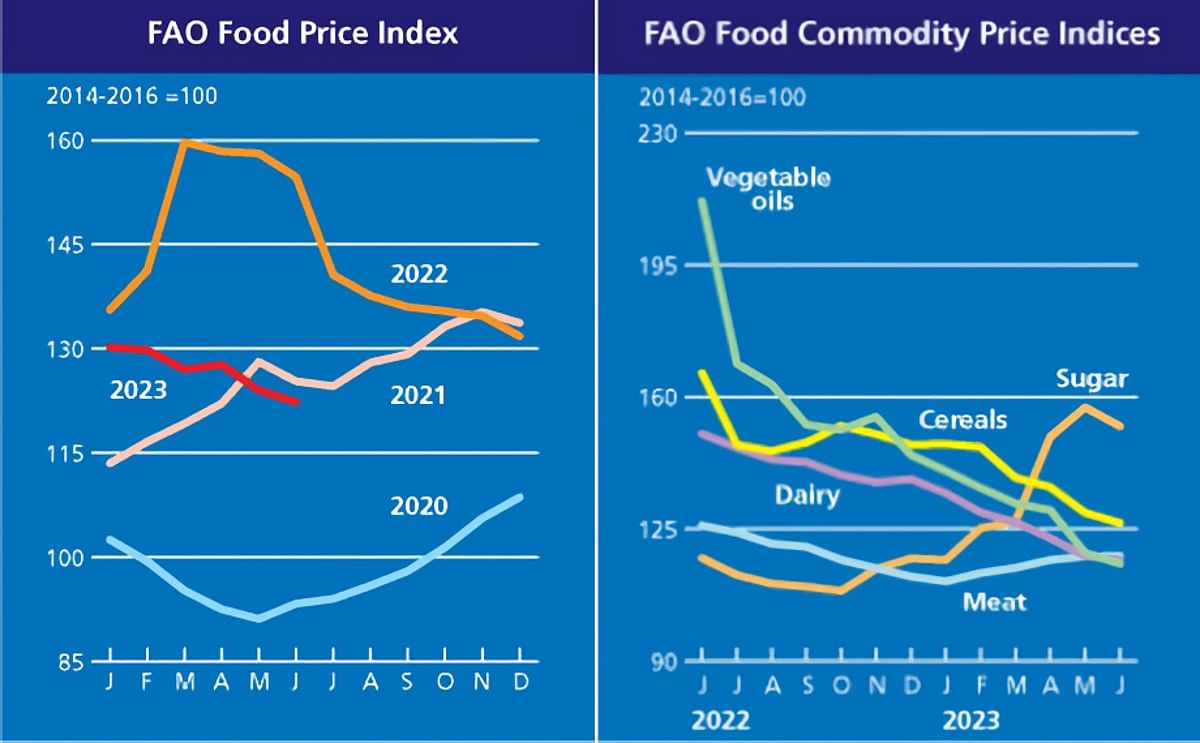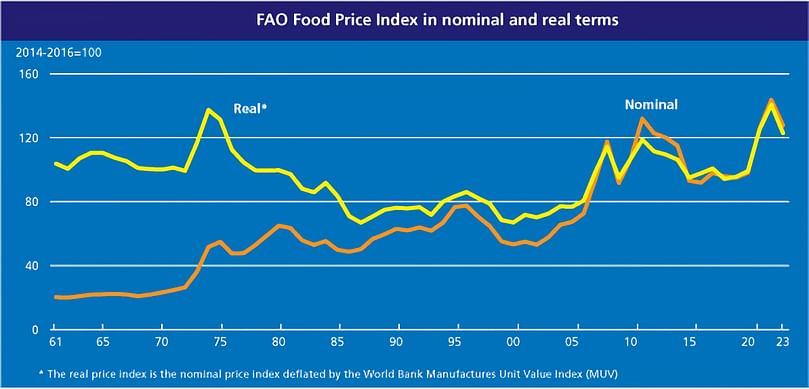FAO Food Price Index continues to fall
FAO Food Price Index continues to fall

The FAO Food Price Index* (FFPI) averaged 122.3 points in June 2023, down 1.7 points (1.4 percent) from May, continuing the downward trend and averaging as much as 37.4 points (23.4 percent) below the peak it reached in March 2022.
The month-on-month decline in the index in June reflected drops in the indices for sugar, vegetable oils, cereals and dairy products, while the meat price index remained virtually unchanged.
The FAO Cereal Price Index averaged 126.6 points in June, down 2.7 points (2.1 percent) from May and as much as 39.7 points (23.9 percent) below its value a year ago. The month-on-month decline reflects a fall in the world prices of all major cereals.
International coarse grain prices fell the most, down 3.4 percent since May. A fifth consecutive monthly decline in international maize prices was mostly driven by increased seasonal supplies from ongoing harvests in Argentina and Brazil.
Amidst concerns over drought conditions, some rain at the end of the month in key maize producing areas of the United States of America also lessened the pressure on maize markets. Among other coarse grains, world prices of barley and sorghum also declined, influenced by spillover effects from maize and wheat markets.
International wheat prices declined by 1.3 percent in June, as harvests in Northern Hemisphere countries started. Ample supplies in the Russian Federation, where also the wheat export tax decreased in the month of June, continued to weigh on prices, while improved crop conditions in the United States of America also contributed to the downward pressure on prices.
International rice prices declined by 1.2 percent in June, amid subdued demand for non-Indica rice and efforts to attract export sales in Pakistan.
The FAO Vegetable Oil Price Index averaged 115.8 points in June, down 2.9 points (2.4 percent) from May and marking the lowest level since November 2020. The continued decline of the index was driven by lower world prices of palm and sunflower oils, more than offsetting higher soy and rapeseed oil quotations.
International palm oil prices dropped for the second consecutive month in June, mainly reflecting prospects of seasonally higher outputs from leading producing countries that coincided with lingering subdued global import demand. Meanwhile, world prices of sunflower oil also continued to fall amid ample global exportable supplies.
By contrast, international soyoil prices rebounded from the previous month, largely underpinned by concerns over excessive dryness in pockets of major growing regions in the United States of America. Similarly, world rapeseed oil prices recovered moderately on unfavourable weather conditions in parts of Canada and Europe.
The FAO Dairy Price Index averaged 116.8 points in June, down 1.0 points (0.8 percent) from May and 33.4 points (22.2 percent) below its corresponding value a year ago. The decline in June was again led by lower international cheese prices, reflecting ample export availabilities, especially in Western Europe, where milk production tracked seasonally higher, while retail sales were somewhat subdued.
Meanwhile, whole milk powder prices fell slightly on lower import purchases by North Asian buyers and increased supplies, especially from New Zealand. By contrast, world butter prices rose, driven by active demand for spot supplies, mainly from the Middle East, and increased internal retail sales in Western Europe.
Skim milk prices increased slightly on higher import purchases to meet short-term needs amid concerns over supplies in the months ahead during the seasonally declining production phase in Western Europe.
The FAO Meat Price Index* averaged 117.9 points in June, virtually unchanged from May, as increases in international quotations for poultry and pig meats were nearly offset by declines in those for bovine and ovine meats. However, compared to its value in June of last year, the index was down 8.1 points (6.4 percent).
International poultry meat prices increased further, reflecting high import demand from East Asia, especially for supplies from Brazil, amidst the continued supply challenges stemming from widespread avian influenza outbreaks.
Meanwhile, pig meat prices increased, underpinned by lingering tight supplies in leading producing regions, especially the European Union. By contrast, international bovine meat prices fell slightly due to increased exportable availabilities, especially in Australia. Similarly, ovine meat prices also fell on high supplies from Oceania.
The FAO Sugar Price Index averaged 152.2 points in June, down 5.1 points (3.2 percent) from May, marking the first decline after four consecutive monthly increases. International sugar quotations remained, however, 34.9 points (29.7 percent) above their levels in the same month last year.
The June decline in international sugar prices was mainly triggered by the good progress of the 2023/24 sugarcane harvest in Brazil and a sluggish global import demand, particularly from China, the world’s second-largest importer of sugar.
However, concerns over the potential impact of the El Niño phenomenon on the 2023/24 sugarcane crops, along with the strengthening of the Brazilian real against the United States dollar, limited the declines in world sugar prices.
The month-on-month decline in the index in June reflected drops in the indices for sugar, vegetable oils, cereals and dairy products, while the meat price index remained virtually unchanged.
The FAO Cereal Price Index averaged 126.6 points in June, down 2.7 points (2.1 percent) from May and as much as 39.7 points (23.9 percent) below its value a year ago. The month-on-month decline reflects a fall in the world prices of all major cereals.
International coarse grain prices fell the most, down 3.4 percent since May. A fifth consecutive monthly decline in international maize prices was mostly driven by increased seasonal supplies from ongoing harvests in Argentina and Brazil.
Amidst concerns over drought conditions, some rain at the end of the month in key maize producing areas of the United States of America also lessened the pressure on maize markets. Among other coarse grains, world prices of barley and sorghum also declined, influenced by spillover effects from maize and wheat markets.
International wheat prices declined by 1.3 percent in June, as harvests in Northern Hemisphere countries started. Ample supplies in the Russian Federation, where also the wheat export tax decreased in the month of June, continued to weigh on prices, while improved crop conditions in the United States of America also contributed to the downward pressure on prices.
International rice prices declined by 1.2 percent in June, amid subdued demand for non-Indica rice and efforts to attract export sales in Pakistan.
The FAO Vegetable Oil Price Index averaged 115.8 points in June, down 2.9 points (2.4 percent) from May and marking the lowest level since November 2020. The continued decline of the index was driven by lower world prices of palm and sunflower oils, more than offsetting higher soy and rapeseed oil quotations.
International palm oil prices dropped for the second consecutive month in June, mainly reflecting prospects of seasonally higher outputs from leading producing countries that coincided with lingering subdued global import demand. Meanwhile, world prices of sunflower oil also continued to fall amid ample global exportable supplies.
By contrast, international soyoil prices rebounded from the previous month, largely underpinned by concerns over excessive dryness in pockets of major growing regions in the United States of America. Similarly, world rapeseed oil prices recovered moderately on unfavourable weather conditions in parts of Canada and Europe.
The FAO Dairy Price Index averaged 116.8 points in June, down 1.0 points (0.8 percent) from May and 33.4 points (22.2 percent) below its corresponding value a year ago. The decline in June was again led by lower international cheese prices, reflecting ample export availabilities, especially in Western Europe, where milk production tracked seasonally higher, while retail sales were somewhat subdued.
Meanwhile, whole milk powder prices fell slightly on lower import purchases by North Asian buyers and increased supplies, especially from New Zealand. By contrast, world butter prices rose, driven by active demand for spot supplies, mainly from the Middle East, and increased internal retail sales in Western Europe.
Skim milk prices increased slightly on higher import purchases to meet short-term needs amid concerns over supplies in the months ahead during the seasonally declining production phase in Western Europe.
The FAO Meat Price Index* averaged 117.9 points in June, virtually unchanged from May, as increases in international quotations for poultry and pig meats were nearly offset by declines in those for bovine and ovine meats. However, compared to its value in June of last year, the index was down 8.1 points (6.4 percent).
International poultry meat prices increased further, reflecting high import demand from East Asia, especially for supplies from Brazil, amidst the continued supply challenges stemming from widespread avian influenza outbreaks.
Meanwhile, pig meat prices increased, underpinned by lingering tight supplies in leading producing regions, especially the European Union. By contrast, international bovine meat prices fell slightly due to increased exportable availabilities, especially in Australia. Similarly, ovine meat prices also fell on high supplies from Oceania.
The FAO Sugar Price Index averaged 152.2 points in June, down 5.1 points (3.2 percent) from May, marking the first decline after four consecutive monthly increases. International sugar quotations remained, however, 34.9 points (29.7 percent) above their levels in the same month last year.
The June decline in international sugar prices was mainly triggered by the good progress of the 2023/24 sugarcane harvest in Brazil and a sluggish global import demand, particularly from China, the world’s second-largest importer of sugar.
However, concerns over the potential impact of the El Niño phenomenon on the 2023/24 sugarcane crops, along with the strengthening of the Brazilian real against the United States dollar, limited the declines in world sugar prices.
Unlike for other commodity groups, most prices utilized in the calculation of the FAO Meat Price Index are not available when the FAO Food Price Index is computed and published; therefore, the value of the Meat Price Index for the most recent months is derived from a mixture of projected and observed prices. This can, at times, require significant revisions in the final value of the FAO Meat Price Index which could in turn influence the value of the FAO Food Price Index.

The FAO Food Price Index rebounded slightly in April 2023
Like to receive news like this by email? Join and Subscribe!
Get the latest potato industry news straight to your WhatsApp. Join the PotatoPro WhatsApp Community!
Highlighted Company
Sponsored Content
Sponsored Content
Sponsored Content
Sponsored Content










